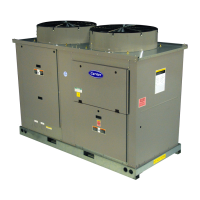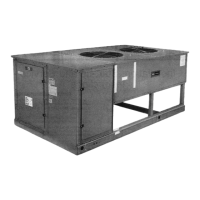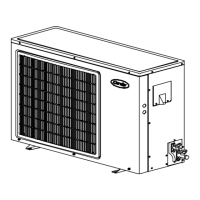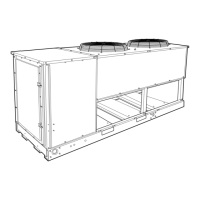42
With all fans operating and all compressors on the circuit
being serviced operating at full capacity, adjust the refrigerant
charge in accordance with the unit charging charts in Fig. 50-
76. It is recommended that the full load superheat be between
15 and 20 F (8.3 and 11.1 C), measured entering the compres-
sors downstream of the accumulator. To use the Charging
Chart, measure refrigerant pressure at the liquid line service
valve, making sure a Schrader depressor is used. Also, measure
liquid line temperature as close to the liquid service valve as
possible. Compare the readings to those measured with the
curve for the appropriate Saturated Suction Temperature,
available on the scrolling marquee display, Temper a-
tures
CIR.A
SST.A or Temperatures
CIR.B
SST.B.
Add or remove charge until the pressure and temperature con-
ditions of the charging chart curve are met. If liquid pressure
and temperature point fall above curve, add charge. If liquid
pressure and temperature point fall below curve, reduce the
charge until the conditions match the curve.
NOTE: Indoor-air cfm must be within normal operating range
of unit.
Trim refrigerant charge into compressor low-side service
port located on the suction service valve using the liquid con-
nection of the refrigerant cylinder and a liquid charging adapter
to vaporize the refrigerant before it enters the system.
If the sight glass is cloudy, check refrigerant charge again.
See Fig. 77 and Fig. 78 for proper locations of filter driers, so-
lenoid valves, sight glasses and TXVs. Ensure all fans and
compressors on the circuit being serviced are operating. Also
ensure maximum allowable liquid lift has not been exceeded. If
the sight glass is cloudy, a restriction could exist in the liquid
line. Check for a plugged filter drier or partially open solenoid
valve. Replace or repair, as needed.
After full load charging is complete, check the circuit super-
heat entering the compressors downstream of the accumulator
at part load conditions to ensure that superheat is greater than
5° F (2.8° C). If superheat is less than 5° F (2.8° C), further
field action to increase the superheat is required to prevent nui-
sance alarms and potential compressor failures.
Once charging is complete, if the digital compressor was
disabled, re-enable the digital operation.
CAUTION
Never charge liquid into the low pressure side of system.
Do not overcharge. During charging or removal of refriger-
ant, be sure indoor fan system is operating. Failure to com-
ply could result in personal injury or equipment damage.
70
80
90
100
110
120
130
50
40
30
20
UID TEMPERATURE AT LIQUID VALVE (DEG C)
UID TEMPERATURE AT LIQUID VALVE (DEG F)
ADD CHARGE IF ABOVE CURVE
REDUCE CHARGE IF BELOW CURVE
50 SST
30 SST
40 SST
60
70
80
90
100
110
120
130
200 250 300 350 400 450 500 550 600
LIQUID PRESSURE AT LIQUID VALVE (PSIG)
Circuit A or B
1500
2000 2500 3000 3500
4000
LIQUID PRESSURE AT LIQUID VALVE (kPag)
50
40
30
20
LIQUID TEMPERATURE AT LIQUID VALVE (DEG C)
LIQUID TEMPERATURE AT LIQUID VALVE (DEG F)
ADD CHARGE IF ABOVE CURVE
REDUCE CHARGE IF BELOW CURVE
50 SST
30 SST
40 SST
Fig. 50 — Charging Chart — 38APD025, 50/60 Hz
NOTE: Charging procedures for MCHX units require very accurate measurement techniques. Charge should be added in small increments. Using cooling
charging charts provided, add or remove refrigerant until conditions of the chart are met. As conditions get close to the point on the chart, add or remove charge in
1/4 lb (0.11 kg) increments until complete. Ensure that all fans are on and all compressors are running when using charging charts.
LEGEND
SST — Saturated Suction Temperature
a38-7169

